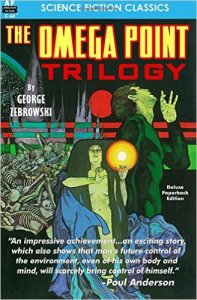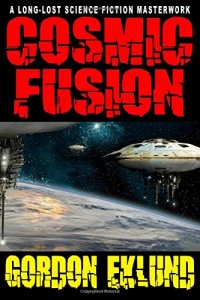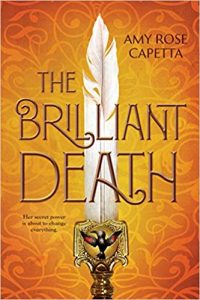Paul Di Filippo reviews George Zebrowski
The Omega Point Trilogy, by George Zebrowski (Armchair Fiction 978-1612872575, $12.95, 280pp, trade paperback) May 31, 2015
 It’s almost a platitude to state that the passage of time is necessary to determine canonicity. Many books which are initially hailed as remarkable works of genius, fated for immortality, vanish from the consensual literary radar after a few years, while other books, delivered to vast silence, slowly emerge over the course of decades as essential. Time, if not the actual arbiter—that role falls to human readers and critics and academics—is at least the essential ingredient for such decisions.
It’s almost a platitude to state that the passage of time is necessary to determine canonicity. Many books which are initially hailed as remarkable works of genius, fated for immortality, vanish from the consensual literary radar after a few years, while other books, delivered to vast silence, slowly emerge over the course of decades as essential. Time, if not the actual arbiter—that role falls to human readers and critics and academics—is at least the essential ingredient for such decisions.
George Zebrowski published three books from 1977 through 1983 which were collected in that latter year as The Omega Point Trilogy. All that publishing history happened from forty to thirty years ago, far enough back for us to finally perhaps say something really solid about them. The three books of the trilogy were Ashes and Stars; The Omega Point; and Mirror of Minds.
Together, I think, they constitute one of the highpoints of that era in our genre, a late-period exfoliation of recomplicated Golden Age space opera, and should be properly invested as such. And now, thanks to a couple of new editions—an ebook from Open Road Media and a hardcopy volume from Armchair Fiction—current readers will get a chance to assess the worth of the trilogy, adding their explicit—by reviews or word-of-mouth—or implicit—by sales figures—support to the status of the work.
Before looking at the texts themselves, let me say that Gregory Luce at Armchair is to be commended for branching out from his usual reprints of older, public domain works by authors no longer with us to repackaging stuff by living writers who can immediately benefit from his support. Although the older stuff is a lot of fun—and essential for historical purposes; see my Robert Moore Williams piece, for instance—newer, overlooked work needs a patron too.
Ashes and Stars opens with one of the most in media res beginnings I can recall. Not only is there 4000 years of galactic backstory lurking just behind the first page, there is also a relatively small-scale situation already in dire progress. The Herculean empire has been wiped out in recent memory by the federation surrounding Earth, a true genocide. A bitter aged general named Gorgias, in charge of the last super-powered Herculean Whisper Ship, contemplates how he shall spend his final days. Unfortunately, his sober, noble plans will be upended by his son, also named Gorgias. This lad is hot for revenge, and with the invincible Whisper Ship he knows he can wreak vast havoc. After an idyll with a woman named Myraa, lover to young Gorgias, the son gets control of the ship and embarks on his course of destruction. With the introduction of two Earth officials, Raf Kurbi and Julian Poincaré, our cast is more or less complete.
The second book chronicles the huge tide of chaos that Gorgias raises, and the battles by the Earthers to stop him. Gorgias goes down to seemingly permanent defeat. But in the third volume, by arcane methods involving Myraa’s essential aid he literally returns from the dead and Kurbi must use all his skills to save the galaxy.
Let’s look at the many different colorful plates which Zebrowski sets spinning in harmonious array.
First comes the super-science space opera aspect of the book. With a blurb from Charles Harness, the trilogy’s lineage is apparent. Not only does it pay homage to Harness’s work, but backwards through him to Cordwainer Smith, van Vogt, Doc Smith and John W. Campbell (the Arcot, Morey and Wade series). It also stands shoulder to shoulder with contemporary peers, such as Samuel Delany and Gordon Dickson. But Zebrowski was not writing mere pastiche. Using the new genre sophistications of the 1970s and 1980s, he created a kind of postmodern space opera that would in turn lead directly to work by such folks as David Zindell, John C. Wright and even, arguably, Hannu Rajaniemi.
After being dazzled by the gosh-wow stuff—and dazzling it is—the next facet to draw our attention is the tone and voice of the book. I can only describe it as Eddisonian or even Shakespearean, with an admixture of the mysticism of John Cowper Powys. Zebrowski employs a rhetoric that achieves a kind of bardic gravitas without being pompous. At times, Zebrowski even evokes Walt Whitman. “Look for him in the strength of suns, in the sigh of magnetic storms, or in the swirl of galaxies. Search for him in your own wills. He is there, freed from the prison of self-awareness, riding the mindless music.”
In line with this high-flown language, the characterizations are intense and larger than-life, while still anchored in familiar emotions. Gorgias is titanic, and yet the less magnificent Kurbi shines forth in the end even more brightly. Bold themes of eternal topicality and antithetical nature appear. The male principle versus the female principle. The savior versus the conqueror. Individuals versus a race. Duty versus egotism.
Certainly the final and perhaps most powerful legacy of the book is its pantheistic, quantum New Age philosophy of the cosmic structure, a feature echoed much later in several novels by Rudy Rucker.
“The interlocking matrix of minds is coextensive with all of nature, which is our outward face, in every stone, in every blade of grass and grain of sand… The material cosmos is the outward manifestation of an infinitely complex inwardness…”
This kind of deep existential substratum, so often lacking in books which are all bright surface, goes a long way toward insuring that The Omega Trilogy will keep on being read for a long time yet.






